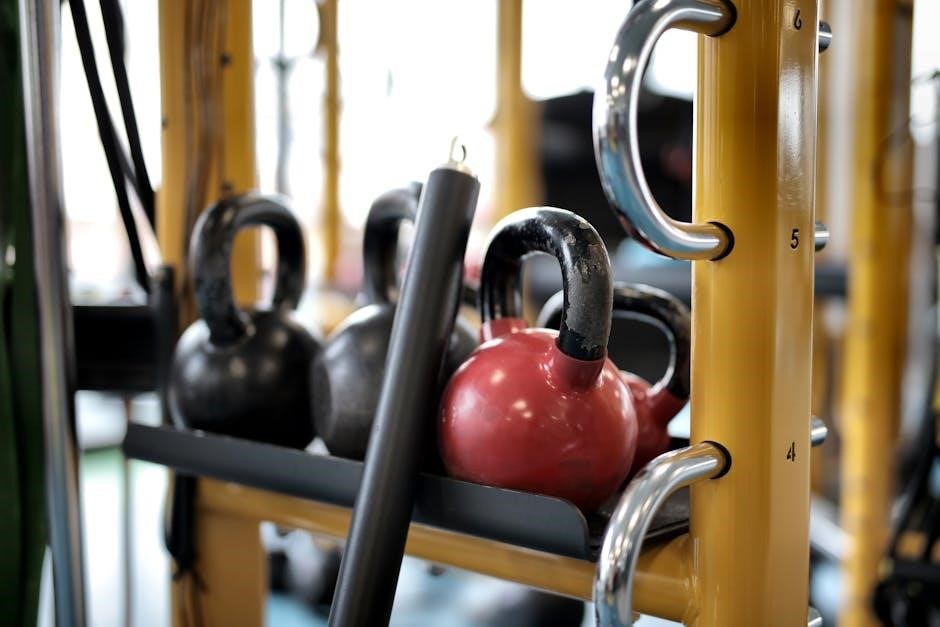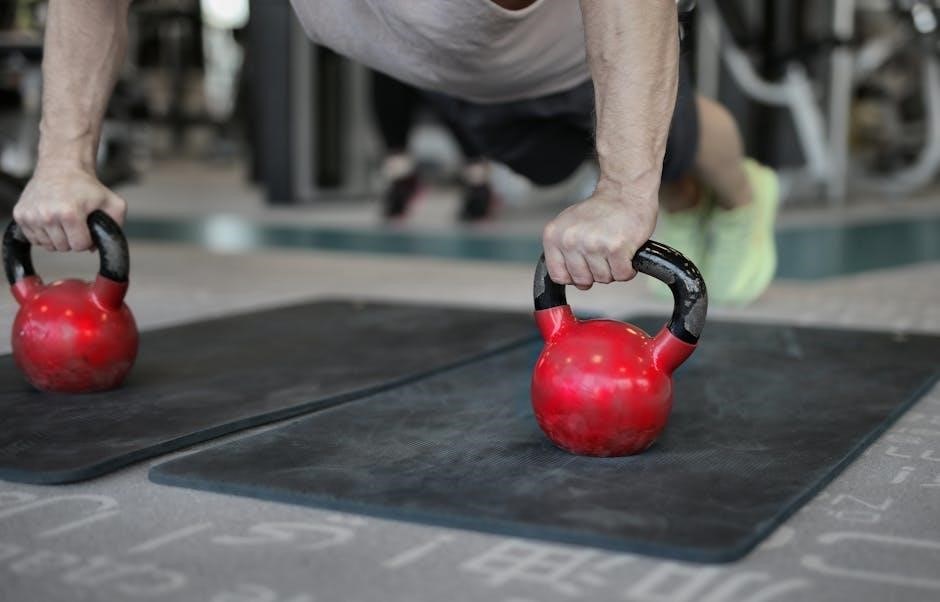
enter the kettlebell pdf
Enter the Kettlebell! by Pavel Tsatsouline revolutionizes strength training with its focus on the ancient Russian kettlebell. This comprehensive guide introduces the swing and Turkish get-up as foundational exercises, offering a powerful approach to full-body fitness and strength, backed by Soviet sports and military traditions.
Overview of the Book and Its Importance
“Enter the Kettlebell!” by Pavel Tsatsouline is a groundbreaking guide that revolutionized kettlebell training worldwide. This book is often regarded as the “bible” of kettlebell workouts, offering a comprehensive approach to strength, conditioning, and mobility. It bridges the gap between traditional Russian kettlebell techniques and modern fitness practices, making it accessible to both beginners and advanced trainees. The book emphasizes functional movement patterns, efficiency, and safety, providing readers with a clear understanding of how to maximize their training. Its importance lies in its ability to simplify complex exercises while delivering measurable results, making it a must-have resource for anyone seeking to enhance their physical performance and overall well-being.
The Author: Pavel Tsatsouline
Pavel Tsatsouline is a world-renowned strength training expert and the author of Enter the Kettlebell!. A former Soviet Union physical training instructor, Pavel is credited with popularizing kettlebell training in the West. His expertise spans strength, conditioning, and mobility, making him a trusted authority in the fitness industry. Known for his no-nonsense, science-backed approach, Pavel has written several influential books and has trained athletes, military personnel, and fitness enthusiasts worldwide. His teaching style emphasizes efficiency, safety, and results, making his methods accessible to all skill levels. Through Enter the Kettlebell!, Pavel has revolutionized how people approach strength training, blending traditional techniques with modern applications.
The Evolution of Kettlebell Training
Kettlebell training has a rich history that spans centuries, evolving from a simple tool for measuring goods in 18th-century Russia to a versatile training device. Originally called girya, kettlebells were adopted by strongmen and farmers for strength and conditioning. By the mid-20th century, they became integral to Soviet sports and military training, emphasizing functional strength and endurance. The modern era saw kettlebells gain global popularity, particularly through Pavel Tsatsouline’s work in the late 1990s. Today, kettlebell training combines traditional lifts with innovative techniques, offering a holistic approach to fitness. Its evolution reflects its adaptability, making it a cornerstone of modern strength and conditioning programs worldwide.

The History and Benefits of Kettlebell Training
Kettlebells originated in Russia as a tool for strength and endurance, evolving into a global fitness phenomenon. They enhance strength, mobility, and cardiovascular health efficiently.
Origins of the Kettlebell in Russia

The kettlebell, known as girya in Russian, has its roots in 18th-century Russia. Initially used as a weight for measuring grain, it evolved into a tool for strength training. Russian strongmen and peasants utilized it for building power and endurance. By the mid-19th century, kettlebells became a staple in circuses and military training, symbolizing strength and resilience. The Soviet Union later formalized kettlebell exercises, incorporating them into sports and military conditioning. Their versatility and effectiveness in building full-body strength made them a cornerstone of Russian physical culture, eventually spreading globally as a premier fitness tool.
The Role of Kettlebells in Soviet Sports and Military
Kettlebells played a pivotal role in Soviet sports and military training, becoming a cornerstone of physical conditioning. In sports, they were used to enhance strength, power, and endurance, with athletes often incorporating kettlebell exercises into their routines for competition preparation. The military adopted kettlebells to build functional strength and resilience among soldiers, ensuring they could perform demanding tasks with efficiency. The Soviet Union formalized kettlebell training, creating structured programs that emphasized exercises like the clean and press, snatch, and Turkish get-up. This systematic approach not only improved physical capabilities but also fostered mental toughness, solidifying the kettlebell’s reputation as an indispensable tool for peak performance in both sports and military contexts.
Physical and Mental Benefits of Kettlebell Training
Kettlebell training offers exceptional physical and mental benefits, making it a versatile and effective workout method. Physically, it enhances strength, endurance, and mobility by engaging multiple muscle groups simultaneously. The dynamic movements improve coordination and balance while boosting cardiovascular health. Mentally, kettlebell training builds discipline, focus, and resilience, as users push through challenging exercises. The repetitive nature of swings and lifts can also have a meditative effect, reducing stress and improving mental clarity. Regular practice fosters a strong mind-body connection, leading to increased confidence and overall well-being. These holistic benefits make kettlebell training a powerful tool for achieving both physical and mental transformation.

Key Concepts in “Enter the Kettlebell!”
Kettlebell training focuses on functional strength, mobility, and efficiency, emphasizing full-body exercises like swings, cleans, and presses to build power and endurance effectively.
The Fundamentals of Kettlebell Exercises
Kettlebell exercises revolve around foundational movements like the swing, clean, and press, which build strength, power, and endurance. Proper form is critical, with emphasis on grip, body positioning, and hinge patterns. The swing, a cornerstone exercise, generates power from the hips, teaching explosive strength and coordination. Mastery of these basics is essential before advancing to more complex movements. Pavel stresses the importance of a strong foundation to ensure safety and effectiveness. By focusing on full-body engagement and dynamic movement, kettlebell exercises promote functional strength and mobility, making them versatile for both beginners and advanced trainees.
The Swing and Turkish Get-Up: Core Exercises
The swing and Turkish get-up are cornerstone exercises in kettlebell training, emphasizing full-body engagement and functional strength. The swing teaches explosive power, hinging at the hips to generate force, while working the hamstrings, glutes, and core. It improves coordination and endurance. The Turkish get-up, a dynamic movement, builds strength, flexibility, and stability by transitioning from lying to standing with the kettlebell overhead. It engages the shoulders, arms, and entire torso, enhancing total-body control and mobility. Mastery of these exercises is crucial for progressing in kettlebell training, as they lay the foundation for more complex movements and ensure safe, effective practice.
Programming for Strength and Conditioning
Effective programming is the backbone of achieving strength and conditioning with kettlebells. The book provides structured routines that balance intensity and volume, ensuring progressive overload. Pavel emphasizes periodization, cycling workouts to avoid plateaus and prevent overtraining. He advocates for focusing on compound movements, integrating swings, cleans, and presses into cohesive programs. The approach is scalable, catering to both beginners and advanced trainees. By combining strength-focused sessions with conditioning workouts, the program enhances muscular endurance and power simultaneously. Pavel’s systematic approach ensures consistency and adaptability, making it easy to tailor routines to individual goals while maintaining a holistic approach to fitness and athleticism.

The Structure of the Book
Enter the Kettlebell! is divided into chapters, each focusing on specific aspects of kettlebell training. The book progresses logically, starting with fundamentals and advancing to specialized techniques, ensuring a clear learning path for readers to master kettlebell exercises and programming.
Chapter Breakdown and Content Overview
The book is organized into chapters that systematically guide readers from foundational knowledge to advanced kettlebell techniques. Early chapters introduce the basics of kettlebell training, including safety, proper form, and essential exercises like the swing and Turkish get-up. Subsequent chapters delve into more complex movements, such as the clean and press, snatches, and integrations with pull-ups for full-body strength. The later sections focus on programming, offering structured training plans tailored for strength, conditioning, and specific fitness goals. Case studies and practical advice are woven throughout, ensuring readers can apply the knowledge effectively. This logical progression makes the book accessible to both novices and experienced trainees.
Progression and Regression of Exercises
Pavel emphasizes the importance of tailoring exercises to individual fitness levels through progression and regression. Progression involves increasing weight, volume, or complexity as strength and skill improve, while regression modifies exercises to suit beginners or prevent injury. For example, the swing can progress from two-handed to one-handed, and further to weighted variations. Regression might involve reducing the range of motion or using assistance. This approach ensures safe and effective training, allowing everyone to challenge themselves appropriately. The book provides clear guidelines for adjusting exercises, making the program adaptable and sustainable for long-term success.
Training Programs for Different Goals
Pavel provides structured training programs tailored to specific objectives, such as building strength, improving endurance, or losing weight. Each program is designed to maximize efficiency, with clear guidelines on intensity, volume, and exercise selection. For strength-focused training, heavy kettlebell lifts like the clean and press are emphasized. Endurance programs incorporate higher repetition swings and snatches to boost cardiovascular fitness. Weight loss programs combine calorie-torching exercises with nutritional advice. These programs are customizable, allowing users to adjust based on their current fitness level and goals. The book also includes sample routines, making it easy to implement the program and track progress effectively.

Advanced Techniques and Strategies
Pavel introduces advanced techniques like the clean and press, snatches, and integrating pull-ups for full-body strength, enhancing efficiency and power in kettlebell training.
Mastering the Clean and Press
The clean and press is a foundational yet advanced exercise in kettlebell training, emphasizing power and precision. Pavel breaks down the movement into manageable parts, focusing on proper form and explosive force. This exercise targets the shoulders, arms, and core, while improving coordination and strength. By mastering the clean and press, practitioners can enhance their overall kettlebell proficiency and achieve greater muscular endurance. Pavel provides detailed cues and progressions, ensuring athletes of all levels can safely and effectively perform this powerful exercise, making it a cornerstone of strength training in Enter the Kettlebell!.
Snatches and Their Variations
The snatch is one of the most dynamic and demanding kettlebell exercises, offering a full-body workout that combines strength, speed, and endurance. In Enter the Kettlebell!, Pavel details the proper technique for executing the snatch, emphasizing explosive power and fluid movement. Variations such as the one-arm snatch and alternating snatch are explored, each targeting different aspects of strength and coordination. These exercises not only build muscular endurance but also enhance cardiovascular fitness. Pavel provides clear progressions and cues to help practitioners master the snatch safely and effectively, making it a key component of advanced kettlebell training.
Integrating Pull-Ups for Full-Body Strength
Pavel emphasizes the importance of pull-ups as a complementary exercise to kettlebell training, enhancing overall strength and muscular development. In Enter the Kettlebell!, he explains how pull-ups target the back, shoulders, and arms, creating a balanced physique. Variations such as weighted pull-ups and interval pull-ups are introduced to challenge even advanced trainees. By incorporating pull-ups into a kettlebell program, individuals can achieve greater upper-body strength and improve functional movement patterns. Pavel’s systematic approach ensures that pull-ups are integrated seamlessly, amplifying the effectiveness of the training regimen and promoting full-body strength and resilience.

The Science Behind Kettlebell Training
Kettlebell training leverages biomechanics and physiological responses to enhance strength, endurance, and mobility. Its dynamic movements engage multiple muscle groups, fostering efficient full-body conditioning and functional fitness.
Physiological Adaptations

Kettlebell training induces significant physiological adaptations, enhancing muscular endurance, strength, and cardiovascular fitness. The dynamic, multi-planar movements increase mitochondrial density in muscles, improving energy production. Regular practice boosts capillarization, enhancing oxygen delivery to tissues. Muscle fibers adapt by increasing myoglobin levels, delaying fatigue. The anaerobic system is strengthened through high-intensity swings and cleans, while aerobic capacity improves with sustained efforts. Bone density also rises due to repetitive loading. These adaptations collectively enhance overall physical resilience, making kettlebell training a comprehensive tool for full-body development. The body’s ability to handle stress and recover is notably improved, supporting long-term health and performance.
Neural and Muscular Efficiency
Kettlebell training enhances neural and muscular efficiency by improving coordination, timing, and muscle synchronization. The repetitive nature of exercises like swings and cleans strengthens the brain-muscle connection, allowing for more precise and powerful movements. This efficiency translates to improved athletic performance and daily functionality; The dynamic loading of kettlebells engages multiple muscle groups simultaneously, fostering functional strength. Over time, the body learns to recruit the right muscles at the right time, reducing energy waste and maximizing output. This neurological adaptation is key to mastering advanced techniques and achieving long-term strength gains. Pavel emphasizes the importance of intent and focus to optimize neural efficiency, ensuring every movement is purposeful and effective.
Injury Prevention and Recovery
Injury Prevention and Recovery
Kettlebell training, as detailed in Enter the Kettlebell!, plays a significant role in injury prevention and recovery by strengthening connective tissues and improving joint mobility. The dynamic nature of kettlebell exercises enhances resilience in the shoulders, hips, and lower back, common areas prone to injury. Pavel emphasizes proper form and gradual progression to avoid overloading joints. For recovery, techniques like controlled movements and isometric holds promote blood flow and muscle repair. Additionally, the book highlights the importance of mobility drills and active recovery to maintain flexibility and reduce muscle tension. These strategies not only prevent injuries but also accelerate recovery, making kettlebell training a sustainable and effective long-term practice.

Practical Applications and Results
Enter the Kettlebell! provides actionable strategies for implementing kettlebell training in real-world scenarios, ensuring measurable results through structured workouts and progressive overload, leading to enhanced strength and endurance.
Success Stories and Case Studies
Enter the Kettlebell! shares inspiring success stories of individuals who transformed their fitness and strength through kettlebell training. Athletes, military personnel, and everyday people achieved remarkable results, including increased strength, endurance, and weight loss. Case studies highlight how kettlebells improved performance in sports and reduced recovery time from injuries. One notable example is a professional athlete who enhanced power and speed, while another is a busy professional who achieved full-body conditioning in minimal time. These real-world examples demonstrate the versatility and effectiveness of kettlebell training, motivating readers to embrace the program and achieve their own fitness goals.
Real-World Implementation of the Program
Enter the Kettlebell! provides practical guidance for implementing its training system in daily life. Readers learn how to create a workout plan, set up a training schedule, and track progress. The book emphasizes consistency and gradual progression, encouraging individuals to start with basic exercises and build strength over time. It also offers tips for integrating kettlebell training into existing fitness routines, making it accessible for those with limited time or space. By focusing on functional movements and full-body engagement, the program ensures efficient workouts that deliver real results, helping readers achieve their fitness goals effectively.
Measuring Progress and Achieving Goals
Enter the Kettlebell! emphasizes the importance of tracking progress to stay motivated and achieve long-term success. Readers are encouraged to set specific, measurable goals, such as increasing kettlebell weight or mastering complex exercises. The book provides methods for logging workouts, monitoring strength gains, and assessing technique improvements. By focusing on incremental progress, individuals can build confidence and stay committed to their training. Celebrating small victories helps maintain momentum, while adjusting goals ensures continued growth. This structured approach enables readers to transform their fitness journey into a sustainable, results-driven endeavor.
Final Thoughts on the Book’s Impact
Enter the Kettlebell! has revolutionized strength training, offering a simple yet powerful system for achieving elite fitness. Pavel’s no-nonsense approach has empowered athletes and enthusiasts worldwide, proving kettlebells are versatile tools for strength and conditioning. The book bridges the gap between traditional methods and modern applications, making it a timeless resource. Its emphasis on technique and progression ensures safety and effectiveness, while the scientific insights provide a deep understanding of physical development. For anyone seeking a comprehensive guide to kettlebell training, this book remains an indispensable resource, continuing to inspire and transform lives through its proven principles.
Continuing Your Kettlebell Journey
After mastering the fundamentals in Enter the Kettlebell!, the next step is to explore advanced techniques and integrate them into your routine. Seek out workshops, DVDs, and online forums where Pavel and other experts share additional drills and insights. Experiment with varying weights and reps to challenge yourself further. Join kettlebell communities to connect with like-minded enthusiasts and gain motivation. Consistency is key, so set long-term goals and track your progress. For those serious about deepening their knowledge, consider certifications like the RKC (Russian Kettlebell Certification) to become an instructor. The journey doesn’t end with the book—it’s just the beginning of a stronger, healthier you.
Resources for Further Learning

Beyond Enter the Kettlebell!, Pavel Tsatsouline offers additional resources for deepening your knowledge. His DVDs and books, such as From Russia with Strength, provide advanced techniques. The Dragon Door website is a treasure trove of kettlebell content, including workshops and certifications like the RKC. Online forums and communities, like Reddit’s r/kettlebell, offer valuable insights and support. YouTube channels dedicated to kettlebell training share instructional videos and tips. Finally, mobile apps like Kettlebell Workouts help you plan and track your routines effectively.